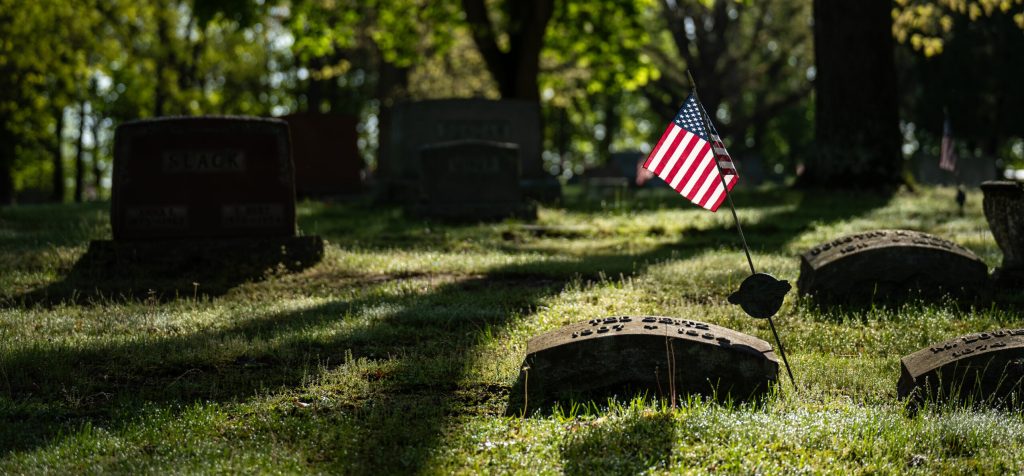
Written by Brennan Berryhill
A key principle of Hillsdale College is remembering and preserving our heritage. There is no better example of this than the tour given of nearby Oak Grove Cemetery, a site dating back to the 1850s, by Professor of History Bradley Birzer, who also holds the Russell Amos Kirk Chair in American Studies. There, the lives of many important people to the community are memorialized.
Dr. Birzer usually leads a group of students in his Jacksonian America or Civil War classes to the cemetery during the fall semesters. While there isn’t a settled date, Dr. Birzer tends to take his classes in October when the leaves start changing color and the beauty of the area shines. They are quick tours, usually lasting 45 minutes, focusing on what the graveyard can tell modern people about the 19th century.
When I asked Dr. Birzer what he was trying to teach his students by taking them to the cemetery, he said a large part was helping them to understand the culture of death in that time period. Oak Grove Cemetery “is simply ideal as a 19th-century Protestant cemetery,” Dr. Birzer said. He explained that it was designed so that there is plenty of space to picnic there—a very 19th century thing to do—and it was originally meant for carriages to go through. Typically, those in the area during that time period would go to the cemetery on Sunday, the Lord’s day, in their carriages and honor the dead.
In the 19th century, “death was a part of life.” Multi-generational living was common, and it was normal for grandparents to be living with the rest of the family until they passed away. It wasn’t atypical to have a family portrait around the body when it was buried. In today’s culture, we often segment elderly people away from the rest of society and try to push away any thought of our mortality. The culture of death is an important concept to understand.
Depending on the class, Dr. Birzer might also delve into the fraternal orders of the 19th century. White Americans almost always belonged to a fraternal order, like the Freemasons, Odd Fellows, or Woodmen of America. These were social groups that performed a lot of community functions, and an estimated 80 percent of white Americans belonged to one in the 19th century. Religion played a major factor in what group one would join. The Knights of Columbus, for example, are a Catholic order. Members would pay dues to the organization, and in return, the orders would provide services like insurance and death benefits. Getting buried was expensive, and fraternal orders would cover the cost. That’s why symbolism is all over the tombstones around Oak Grove. For example, a wooden stump engraved on the headstone represents the Woodmen of America. Many of the fraternal orders died during the Great Depression, but a few, including the Knights of Columbus, are still around today.
A highlight of the tour for Dr. Birzer is finishing at the grave of Ransom Dunn. An abolitionist pastor, Dunn taught at Hillsdale for more than 40 years, also raising funds and even serving as interim president. On a larger scale, Dr. Birzer’s favorite part of the tour is seeing his students think in a 19th century mindset. While the cemetery is still used, it is a “nice window into 200 years ago.”
While he typically gives his tours for classes, Dr. Birzer says they are open to any student who wants the experience. When I asked why a student might consider taking the tour, he emphasized that the cemetery is extremely beautiful, and he keeps his tours short because of classes. Sometimes, when it’s near Halloween time, he’ll end the tour with his students reading a short story like Ray Bradbury’s “The Jar.”
“Every grave is its own story, and every person had their own story,” Dr. Birzer told me. He lives right across the street from the cemetery and gets to appreciate the history every day at his doorstep. He said that every person buried at Oak Grove lived a very full life, though for most of them, we only have a stone marker to go by. There are about 300 Civil War veterans buried there, and Dr. Birzer said that two of them fought with Custer at the Battle of Gettysburg. Many more stories lie dormant, and Dr. Birzer would hate for anyone to be forgotten. “Life is fascinating, and death is equally fascinating,” he said. He wants to be cognizant of the history and respectful of the dead every time he does the tour.
There is a lot to learn about the foreign world that is our own past, and one of the best ways is by taking a stroll through a cemetery. Dr. Birzer’s tour is open to every student, but whether or not you join him for a visit to the graveyard, it is worth pondering the heritage we’ve been given and cultivating a spirit of gratitude for the giants upon whose shoulders we stand.
Brennan Berryhill, ’27, hails from Denver, Colorado, and when he isn’t writing or obsessively taking notes, you can find him playing trombone, debating, or nerding out over football.
Published in April 2024
